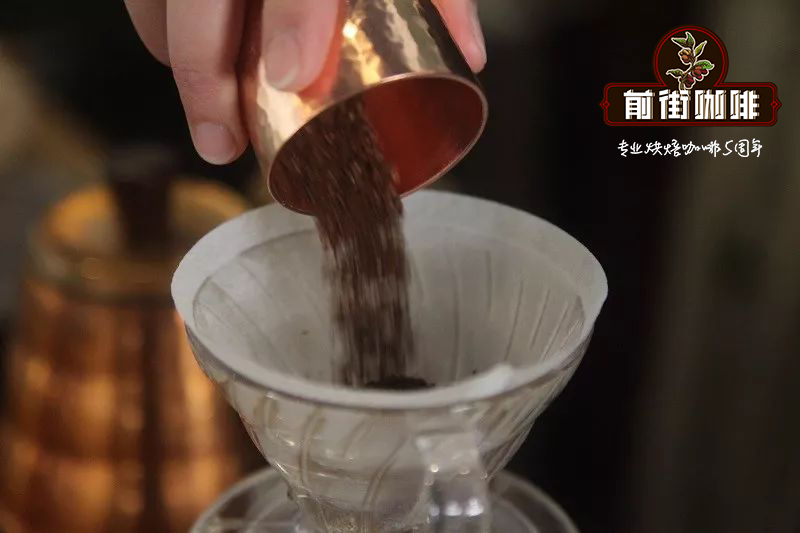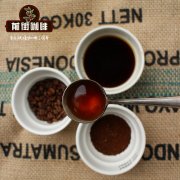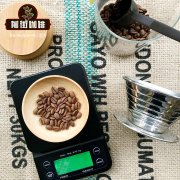A cup of Costa Rican coffee costs more than a cup of coffee compared with a siphon pot.

Professional coffee knowledge exchange more coffee bean information please follow the coffee workshop (Wechat official account cafe_style)
What I want to share with you today is the comparative cooking demonstration of Costa Rican coffee beans hand-brewed-siphon.
The protagonist is very popular recently-the black honey of Shumawa Manor in Costa Rica treats coffee beans.
……
All right, let's call it "black honey" for short.
Country: Costa Rica
Grade: SHB
Baking degree: medium baking
Treatment method: black honey treatment
Variety: Kaduai
Manor: Shumawa Manor
Flavor description: sweet and colorful fruits, honey, toffee
[Shumawa Manor]
Shumawa Manor is located in the highest coffee-growing area in Costa Rica, which is the densest fruit-growing area in Costa Rica. The owner of the manor mainly grows passion fruit, but the amount of coffee is very small, only in a special area to grow coffee, take special care, only pick ripe coffee yellow fruit. The unique variety of Huang Kadu Aimi in the manor is treated with rich changes in the overall taste and a full sense of grease plus good cleanliness! The sweetness is excellent, with rich and varied levels of acidity from berries to citrus.
The hand rushes black honey:
V60 hand punch parameters:
Degree of grinding: BG mill: 4e
Water temperature: 90 degrees
Powder weight: 15g
Powder / water ratio: 1:15
Total cooking time: 1 minute 50 seconds.
After the first stage of water injection, wait for the liquid level to drop.
Specific manual cooking techniques:
Steaming: 30 grams of water, 30 seconds
The first stage of water injection: slowly circle water injection 90 grams, to 120 grams reading stop, wait for the liquid level to drop to the powder layer surface.
The second stage of water injection: increase the amount of water around the circle, inject 105 grams of water, stop the reading to 225 grams, wait for the powder layer to be exposed, remove the filter cup.
Siphon black honey:
Siphon cooking parameters:
Powder weight: 20g
Water temperature: 91 degrees
Degree of grinding: BG mill: 5D
Powder / water ratio: 1:12
Total cooking time: 1 minute 10 seconds.
Specific siphon cooking techniques:
Use the post-powder method, that is, first boil the water to the pot, and then add powder to stir.
The first step: boil until the fisheye bubble is formed, insert the pot tightly; when the hot water rises to the pot, measure the water temperature, 91 degrees. Adjust the firepower until the water column is stable and there are no bubbles in the upper pot. Then cross the cross and gently press the powder to wet completely.
The second step: steam for 38 seconds, observe the bubble state of the powder layer, stir in a circle for the first time, and stir three times.
Step 3: boil to 52 seconds, turn off the engine, wait for the siphon, and the coffee flows back to the pot.
It is very important to stir the powder for the first time. The powder should be moist evenly but not completely dispersed.
[Costa Rican coffee beans hand-brewed-siphon] flavor comparison
V60 hand-made black honey: rich in aroma of flowers and fruits, fresh and fermented, smooth taste, obvious layering, soft acidity after the temperature drop, and a slight sense of tea at the end.
Siphon black honey: the sweet and sour taste is prominent and full-bodied, but the fermented taste and sour taste are not irritant. at first, the taste is not as smooth as the hand, and the taste becomes softer and sweeter after a slight drop in temperature.
[Costa Rican Coffee beans hand-made VS siphon] explanation of brewing parameters
First of all, we need to understand the characteristics of the bean "black honey".
The cup test flavor of black honey is as follows: sweet and colorful fruits (strawberry, apple, grape, citrus) unforgettable taste of honey and toffee, delicate and mellow like silky cream (such as the long finish of Darjeeling black tea)
Therefore, our main extraction targets are the sweet and sour flavor and fermented flavor in the front and middle, as well as the mellow finish.
Costa Rica's SHB beans are relatively high above sea level, hard, and have excellent sweet and sour texture (that is, they are resistant to extraction), so even if they are moderately baked, we can extract them with water of 90 degrees Celsius and 91 degrees Celsius, without having to worry too much about overextraction and bitterness.
Comparison of original cooking records of Costa Rican coffee beans
Degree of grinding: BG mill: 4e VS 5D
As the baking time of this bean is September 17, just 10 days, almost reached the best flavor period; exhaust reaction into the end; hand filter cup V60 filtration speed is faster, to sum up, hand grinding needs medium fineness, while siphon grinding is slightly thicker than hand grinding.
Water temperature: 90 degrees VS 91 degrees
Hand extraction time is long, so the water temperature of 90 degrees is suitable, you can extract more complete and rich flavor substances without over-extraction.
The siphon extraction time is short, so the relative water temperature is 91 degrees, which can balance the extraction rate.
Powder / water ratio: 1:15 VS 1:12
The extraction process of hand flushing is a cooling extraction process, the extraction temperature of the latter stage is lower than that of the front stage, and it is relatively difficult to overextract. Increasing the ratio of powder to water can improve the sense of hierarchy and richness.
Siphon extraction is an immersion extraction process, the lower the extraction efficiency (concentration problem), but can maintain a high water temperature, so that a certain section of the flavor is relatively complete and prominent. The powder water is relatively small in order to highlight the sour and sweet flavor of the front and middle section and avoid the woody flavor of the back section extracted too early.
Finally, it is concluded that:
This Costa Rican coffee bean is a bean with obvious flavor and unique fermentation flavor, which is especially suitable for hand brewing and siphon. So today we chose this Costa Rican coffee bean as the protagonist of the brewing demonstration (the protagonist is obviously a non-photogenic barista).
As it was the first time to make a demonstration of brewing, there was no time for video recording, so we had to take pictures and explain it. (due to lack of manpower, our poor baristas had to cook and take pictures of each other. ), try to explain it in video in the future. If there is anything wrong, you are welcome to point out that the cooking parameters are for reference only.
Costa Rican coffee bean brand recommendation
The Costa Rican beans baked in front street coffee are fully guaranteed in terms of brand and quality. And more importantly, the performance-to-price ratio is extremely high, a pack of 227 grams, the price is only 95 yuan. According to the calculation of 15 grams of powder per cup of coffee, a bag of coffee can make 15 cups of coffee, which costs only about 6 yuan per cup, which is recommended by conscience compared to the price sold in cafes for dozens of yuan a cup.
Important Notice :
前街咖啡 FrontStreet Coffee has moved to new addredd:
FrontStreet Coffee Address: 315,Donghua East Road,GuangZhou
Tel:020 38364473
- Prev

The reason why Costa Rican coffee is fruity, the price of Costa Rican coffee is not high and the quality is high.
Professional coffee knowledge exchange more coffee bean information Please follow the coffee workshop (Wechat official account cafe_style) Coffee beans produced in the high latitudes of Costa Rica are famous in the world, rich, mild, but extremely sour, the Costa Rican coffee beans here are carefully processed, which is why there is high quality coffee. Costa Rica is located in Tara.
- Next

Is Costa Rican organic coffee beans expensive? what's the taste of Costa Rican coffee beans?
Professional coffee knowledge exchange more coffee bean information Please follow the coffee workshop (Wechat official account cafe_style) Coffee beans produced in the high latitudes of Costa Rica are famous in the world, rich, mild, but extremely sour, the Costa Rican coffee beans here are carefully processed, which is why there is high quality coffee. Costa Rica is located in Tara.
Related
- Does Rose Summer choose Blue, Green or Red? Detailed explanation of Rose Summer Coffee plots and Classification in Panamanian Jade Manor
- What is the difference between the origin, producing area, processing plant, cooperative and manor of coffee beans?
- How fine does the espresso powder fit? how to grind the espresso?
- Sca coffee roasting degree color card coffee roasting degree 8 roasting color values what do you mean?
- The practice of lattes: how to make lattes at home
- Introduction to Indonesian Fine Coffee beans-- Java Coffee producing area of Indonesian Arabica Coffee
- How much will the flavor of light and medium roasted rose summer be expressed? What baking level is rose summer suitable for?
- Introduction to the characteristics of washing, sun-drying or wet-planing coffee commonly used in Mantenin, Indonesia
- Price characteristics of Arabica Coffee Bean Starbucks introduction to Manning Coffee Bean Taste producing area Variety Manor
- What is the authentic Yega flavor? What are the flavor characteristics of the really excellent Yejasuffi coffee beans?

